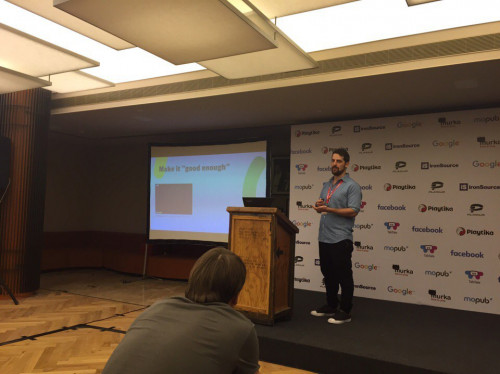How much time to spend on creating a prototype, what graphics to use and how to playtest it, – he told Ron Rejwan, Co-founder and CEO at Jelly Button, at the Casual Connect Tel Aviv 2016 conference.

Jelly Button was founded in 2011, and by 2016 the company had grown to over 80 people. The most popular game of the studio is Pirate Kings. The title has a 4.5 star rating on Google Play. The number of downloads on Google Play alone is more than 50 million. By revenue, the game was in the box office Top 5 apps in 50 countries on iOS and in 8 countries on Google Play.
Before launching the game, Jelly Button prototyped it for a very long time. On average, the company creates 7-8 prototypes in six months, and work on the game can last several years.
Rejwan told what, in his opinion, is a prototype. This is the cheapest possible layout of the game with a minimum of features. It should be understood, he noted, that the prototype does not necessarily need to be assembled on the platform for which it is designed. You can start at least with a paper layout — the main thing is to achieve your goals.
What are these goals? The most important of them is obvious, says Rejwan. In the process, it is possible to understand whether the game is good or not. It is important to find out as early as possible whether the player likes the game cycle, and for this you need to test it as soon as possible. “Innovation is cool, but if you just stuff the game with different new mechanics without a strong cycle, you won’t get far,” says Rejwan.
The next goal is to save and estimate costs. Before launching a major project, you need to understand what it will cost. Prototypes help to find out what technological difficulties can be encountered during the launch process. Is what you have in mind feasible? How much will server maintenance cost? Do you have enough capacity to launch the project? All these questions should be answered by a prototype.
Rejwan gave some tips on how to prototype the game.
It is necessary to plan everything in advance — to write the shortest possible disdoc for 1-2 pages, where to describe what you want to achieve, how the game should look like in general. Each feature needs to be analyzed, whether it is needed at this stage or not. Then the deadlines are set, from two days to a month. At this stage, it is important to determine what needs to be done and what you will do if there is time left.
To meet the deadlines, it is useful to set a specific date for the playtest.
“You don’t need to optimize — it’s a prototype, throw it away later anyway,” advises Rejwan.

Rejwan emphasized that there is no need to “bring beauty” at the prototyping stage. He recommended using free assets in all cases, where possible. “Let the game be of passing quality. Do not try to do it beautifully right away. In general, Supercell first tests the game with black and blue squares to understand that everything is OK. Then he brings beauty. If the game turns out to be good, then add graphics and it will become beautiful. But the graphics won’t save a lame game,” says Rejwan.
The following advice naturally follows from the previous one. At the stage of the playtest, it is necessary to explain to the test group that the prototype can and should be unattractive. “It is very difficult for playtesters to abstract from an unpresentable kind of game. So explain again and again that circles are Vikings, squares are dragons,” says Rejwan.
It is important to remember that there is no need to test bugs during the playtest, a game idea is being tested here. This also needs to be reminded to the test group.
While the testers are playing, there is no need to ask any questions. “Watch how the playtesters react. Don’t ask them anything, just watch them. I let a group of people play, I watch the group dynamics. If they play buttler and yell at each other, then everything worked out!”, — says Rejvan.
He advised not to defend the game during the playtest: “You are not here to “stroke the ego”, you are here to understand whether the game is normal or not.”
Questions about the game should be asked after the testers have played. And here it is necessary to be as specific as possible: what exactly did you like, was it easy to play, what kind of feelings from multiplayer. So you need to go through the whole game, discuss every aspect. If the creators of the game are personally familiar with the playtesters, then it may not be easy for them to tell the truth to their face. To do this, Rejwan advises conducting anonymous Google surveys. And here it is important to voice to testers that they are completely anonymous.
Rejwan recommended creating as many iterations as possible: “We corrected something — and back to the playlist, and again, and again.”
In addition, he advised to make post-mortems for each prototype: “Write down everything that went wrong. If there is a mechanic that I like, or an interesting cycle, then even if I have discarded it now, then it may come in handy for me.”
